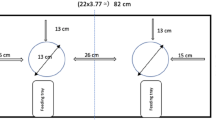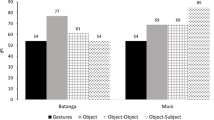Abstract
Response facilitation has often been portrayed as a “low level” category of social learning, because the demonstrator’s action, which is already in the observer’s repertoire, automatically triggers that same action, rather than induces the learning of a new action. One way to rule out response facilitation consists of introducing a delay between the demonstrator’s behavior and the observer’s response to let their possible effects wear off. However, this may not rule out “delayed response facilitation” in which the subject could be continuously “mentally rehearsing” the demonstrated actions during the waiting period. We used a do-as-the-other-did paradigm in two orcas to study whether they displayed cognitive control regarding their production of familiar actions by (1) introducing a delay ranging from 60 to 150 s between observing and producing the actions and (2) interspersing distractor (non-target) actions performed by the demonstrator and by the subjects during the delay period. These two manipulations were aimed at preventing the mental rehearsal of the observed actions during the delay period. Both orcas copied the model’s target actions on command after various delay periods, and crucially, despite the presence of distractor actions. These findings suggest that orcas are capable of selectively retrieving a representation of an observed action to generate a delayed matching response. Moreover, these results lend further support to the proposal that the subjects’ performance relied not only on a mental representation of the specific actions that were requested to copy, but also flexibly on the abstract and domain general rule requested by the specific “copy command”. Our findings strengthen the view that orcas and other cetaceans are capable of flexible and controlled social learning.
Similar content being viewed by others
Availability of data and material
Data are uploaded as Supplementary Material in this initial submission.
Code availability
No code was used in relation to this paper.
References
Abramson JZ, Hernández-Lloreda MV, García L, Colmenares F, Aboitiz F (1871) Call J (2018) Imitation of novel conspecific and human speech sounds in the killer whale (Orcinus orca). Proc R Soc B 285:20172171
Abramson JZ, Hernández-Lloreda MV, Call J, Colmenares F (2013) Experimental evidence for action imitation in killer whales (Orcinus orca). Anim Cogn 16:11–22
Abramson JZ, Hernández-Lloreda MV, Esteban JA, Colmenares F, Aboitiz F, Call J (2017) Contextual imitation of intransitive body actions in a Beluga whale (Delphinapterus leucas): a ‘do as other does’ study”. PLoS ONE 12:e0178906
Bandura A (1969) Social-learning theory of identificatory processes. Handbook of socialization theory and research. Rand McNally & Company, Chicago, pp 213–262
Bard KA (2007) Neonatal imitation in chimpanzees (Pan troglodytes) tested with two paradigms. Anim Cogn 10:233–242
Barrett-Lennard LG, Heise K (2007) The natural history and ecology of killer whales: foraging specialization in a generalist predator. In: Estes JA, Brownell RL, DeMaster DP, Doak DF, Williams TM (eds) Whales, whaling and ocean ecosystems. University of California Press, Berkely, pp 163–173
Bates LA, Byrne RW (2010) Imitation: what animal imitation tells us about animal cognition. Wiley Interdiscip Rev Cogn Sci 1:685–695. https://doi.org/10.1002/wcs.77
Bauer GB, Johnson CM (1994) Trained motor imitation by bottlenose dolphins (Tursiops truncatus). Percept Mot Ski 79:1307–1315. https://doi.org/10.2466/pms.(1994).79.3.1307. (PMID: 7899015)
Bering JM, Bjorklund DF, Ragan P (2000) Deferred imitation of object-related actions in human-reared juvenile chimpanzees and orangutans. Dev Psychobiol 36:218–232
Bjorklund DF, Bering JM (2003) A note on the development of deferred imitation in enculturated juvenile chimpanzees (Pan troglodytes). Develop Rev 23:389–412
Bjorklund DF, Bering JM, Ragan P (2000) A two-year longitudinal study of deferred imitation of object manipulation in a juvenile chimpanzee (Pan troglodytes) and orangutan (Pongo pygmaeus). Dev Psychobiol 37:229–237
Bjorklund DF, Yunger JL, Bering JM, Ragan P (2002) The generalization of deferred imitation in enculturated chimpanzees (Pan troglodytes). Anim Cogn 5:49–58
Boesch C, Tomasello M (1998) Chimpanzee and human cultures. Curr Anthropol 39:591–614
Buttelmann D, Zmyj N, Daum M, Carpenter M (2013) Selective imitation of in-group over out-group members in 14-month-old infants. Child Dev 84:422–428
Byrne RW (2002) Imitation of novel complex actions: what does the evidence from animals mean? Adv Study Behav 31:77–105. https://doi.org/10.1016/S0065-3454(02)80006-7
Byrne RW (2009) Animal imitation. Curr Biol 19:R111–R114. https://doi.org/10.1016/j.cub.2008.11.027. (PMID: 19211046)
Byrne RW, Russon AE (1998) Learning by imitation: a hierarchical approach. Behav Brain Sci 21:667–684
Byrne RW (1994) The evolution of intelligence. In: Slater PJ, Halliday TR (eds) Behaviour and evolution. Cambridge University Press, Cambridge
Call J (2001) Body imitation in an enculturated orangutan (Pongo pygmaeus). Cybern Syst 32:97–119
Call J, Carpenter M (2002) Three sources of information in social learning. Imitation in animals and artifacts, pp 211–228
Cirelli LK (2018) How interpersonal synchrony facilitates early prosocial behavior. Curr Opin Psychol 20:35–39
Cracco E, Bardi L, Desmet C, Genschow O, Rigoni D, De Coster L, Radkova I, Deschrijver E, Brass M (2018) Automatic imitation: a meta-analysis. Psychol Bull 144:453. https://doi.org/10.1037/bul0000143
Custance DM, Whiten A, Bard KA (1995) Can young chimpanzees (Pan troglodytes) imitate arbitrary actions? Hayes & Hayes (1952) revisited. Behaviour 132:837–859
Dean LG, Vale GL, Whiten A (2018) Imitation, social learning, and cultural traditions. The international encyclopedia of anthropology, pp 1–10
Deecke VB, Ford JKB, Spong P (2000) Dialect change in resident killer whales: implications for vocal learning and cultural transmission. Anim Behav 40:629–638. https://doi.org/10.1006/anbe.2000.1454
Filatova O, Deecke VB, Ford JK, Matkin CO, Barrett-Lennard LG, Guzeev MA, Burdin AM, Hoyt E (2012) Call diversity in the North Pacific killer whale populations: implications for dialect evolution and population history. Anim Behav 83(3):595–603
Filatova OA, Samarra FI, Deecke VB, Ford JK, Miller PJ, Yurk H (2015) Cultural evolution of orca calls: background, mechanisms and consequences. Behaviour 152:2001–2038. https://doi.org/10.1163/1568539X-00003317
Ford JKB (1991) Vocal traditions among resident killer whales (Orcinus orca) in coastal waters of British Columbia. Can J Zool 69:1454–1483. https://doi.org/10.1139/z91-206
Fugazza C, Miklósi Á (2014) Deferred imitation and declarative memory in domestic dogs. Anim Cogn 17:237–247
Fugazza C, Miklósi Á (2015) Social learning in dog training: the effectiveness of the Do as I do method compared to shaping/clicker training. Appl Animal Behav Sci 171:146–151
Fugazza C, Pogány Á, Miklósi Á (2016a) Do as I… Did! Long-term memory of imitative actions in dogs (Canis familiaris). Anim Cogn 19:263–269
Fugazza C, Pogány Á, Miklósi Á (2016b) Recall of others’ actions after incidental encoding reveals episodic-like memory in dogs. Curr Biol 26:3209–3213
Fuhrmann D, Ravignani A, Marshall-Pescini S, Whiten A (2014) Synchrony and motor mimicking in chimpanzee observational learning. Sci Rep 4:1–7
Galef BG (2013) Imitation and local enhancement: detrimental effects of consensus definitions on analyses of social learning in animals. Behav Proc 100:123–130
Galef BG, Whiten A (2017) The comparative psychology of social learning. APA handbook of comparative psychology: perception, learning, and cognition. American Psychological Association, Washington, pp 411–439
Guinet C (1991) Intentional stranding apprenticeship and social play in killer whales (Orcinus orca). Can J Zool 69:2712–2716
Guinet C, Bouvier J (1995) Development of intentional stranding hunting techniques in killer whale (Orcinus orca) calves at Crozet Archipelago. Can J Zool 73:27–33
Handegard NO, Boswell KM, Ioannou CC, Leblanc SP, Tjøstheim DB, Couzin ID (2012) The dynamics of coordinated group hunting and collective information transfer among schooling prey. Curr Biol 22:1213–1217
Hayes KJ, Hayes C (1952) Imitation in a home-raised chimpanzee. J Comp Psychol 45:450–459
Herman LM (2002) Vocal, social, and self-imitation by bottlenosed dolphins. In: Dautenhahn K, Nehaniv C (eds) Imitation in animals and artifacts. MIT Press, Cambridge, UK, pp 63–108
Herrmann E, Joly M, Loyant L. (2022). The evolution of primate short-term memory. Anim Behav Cogn
Heyes CM (1994) Social learning in animals: categories and mechanisms. Biol Rev 69:207–231
Heyes C (2001) Causes and consequences of imitation. Trends Cogn Sci 5:253–261
Heyes C (2011) Automatic imitation. Psychol Bull 137:463
Heyes C (2021) Imitation. Curr Biol 31:R228–R232
Heyes CM, Ray ED (2000) What is the significance of imitation in animals? In: Advances in the study of behavior, vol 29. Academic Press, pp 215–245
Heyes CM. (2013) What Can Imitation Do for Cooperation? In Stereiny K, Joyce R, Calcott B, Fraser B (eds) Cooperation and Its Evolution, MIT Press, pp 313
Hoppitt W, Laland KN (2008) Social processes influencing learning in animals: a review of the evidence. Adv Study Behav 38:105–165
Hribar A, Sonesson G, Call J (2014) From sign to action Studies in chimpanzee pictorial competence. Semiotica 198:205–240
Huber L, Range F, Voelkl B, Szucsich A, Viranyi Z, Miklosi A (2009) The evolution of imitation: what do the capacities of non-human animals tell us about the mechanisms of imitation? Phil Trans R Soc B 364:2299–2309. https://doi.org/10.1098/rstb.2009.0060
Huber L, Range F, Virányi Z (2014) Dog imitation and its possible origins. Domestic dog cognition and behavior. Springer, Berlin, Heidelberg, pp 79–100
Jaakkola K, Guarino E, Rodriguez M (2010) Blindfolded imitation in a bottlenose dolphin Tursiops truncatus. Int J Comp Psychol. https://doi.org/10.46867/IJCP.2010.23.04.08
Jaakkola K, Guarino E, Rodriguez M, Hecksher J (2013) Switching strategies: a dolphin’s use of passive and active acoustics to imitate motor actions. Anim Cogn 16:701–709
Kuczaj SA II, Yeater DB (2006) Dolphin imitation: who, what, when, and why? Aquat Mamm 32:413
Launay J, Tarr B, Dunbar RI (2016) Synchrony as an adaptive mechanism for large-scale human social bonding. Ethology 122:779–789
Lopez JC, Lopez D (1985) Killer whales of Patagonia and their behaviour of intentional stranding while hunting nearshore. J Mammal 66:181–183
Marino L (2022) Cetacean brain, cognition, and social complexity. In: di Giuseppe Notarbartolo S, Bernd W (eds) Marine mammals, the evolving human factor. Springer, Cham, pp 113–148
Meltzoff AN, Williamson RA (2013) Imitation: social, cognitive, and theoretical perspectives. In: Zelazo PD (ed) The Oxford handbook of developmental psychology: body and mind, vol 1. Oxford University Press, Oxford, pp 651–682
Mercado E, Scagel A (2022) Second verse, same as the first: learning generalizable relational concepts through functional repetition. Anim Cogn 26:1–11
Miller PJ, Bain DE (2000) Within-pod variation in the sound production of a pod of killer whales. Orcinus Orca Anim Behav 60(5):617–628
Myowa-Yamakoshi M (2018) The evolutionary roots of human imitation, action understanding and symbols. Interact Stud 19:183–199
Nagasaka Y, Chao ZC, Hasegawa N, Notoya T, Fujii N (2013) Spontaneous synchronization of arm motion between Japanese macaques. Nature Sci Rep. https://doi.org/10.1038/srep01151
Pack AA, Herman LM (2004) Bottlenose dolphins (Tursiops truncatus) comprehend the referent of both static and dynamic human gazing and pointing in an object-choice task. J Comp Psychol 118:160
Pitman RL, Durban JW (2012) Cooperative hunting behaviour, prey selectivity and prey handling by pack ice killer whales (Orcinus orca), type B, in Antarctic Peninsula waters. Mar Mammal Sci 28:16–36. https://doi.org/10.1111/j.1748-7692.2010.00453.x
Rendell L, Whitehead H (2001) Culture in whales and dolphins. Behav Brain Sci 24:309–324. https://doi.org/10.1017/S0140525X0100396X. (discussion 324–382)
Riesch R, Barrett-Lennard LG, Ellis GM, Ford JKB, Deecke VB (2012) Cultural traditions and the evolution of reproductive isolation: ecological speciation in killer whales? Biol J Linn Soc 106:1–17
Similä T, Ugarte F (1993) Surface and underwater observation of cooperatively feeding killer whales in Northern Norway. Can J Zool 71:1494–1499
Smith TG, Siniff DB, Reichle R, Stone S (1981) Coordinated behavior of killer whales, (Orcinus orca), hunting a crabeater seal, (Lobodon carcinophagus). Can J Zool 59:1185–1189
Subiaul F (2010) Dissecting the imitation faculty: The multiple imitation mechanisms (MIM) hypothesis. Behav Proc 83:222–234
Tennie C, Glabsch E, Tempelmann S, Bräuer J, Kaminski J, Call J (2009) Dogs, Canis familiaris, fail to copy intransitive actions in third-party contextual imitation tasks. Anim Behav 77:1491–1499
Thorpe WH (1963) Learning and instinct in animals, 2nd edn. Methuen, London
Tomasello M (1990) Cultural transmission in the tool use and communicatory signaling of chimpanzees? In: Parker ST, Gibson KR (eds) Language and intelligence in monkeys and apes: Comparative developmental perspectives. Cambridge University Press, Cambridge, pp 274–311
Tomasello M (2022) The Evolution of Agency: Behavioral Organization from Lizards to Humans. MIT Press
Tomasello M, Kruger AC, Ratner HH (1993) Cultural learning. Behav Brain Sci 16:495–511
Topal J, Byrne RW, Miklosi A, Csanyi V (2006) Reproducing human actions and action sequences: “do as I do!’ in a dog. Anim Cogn 9:355–436. https://doi.org/10.1007/s10071-006-0051-6. (PMID: 17024511)
van Schaik CPV (2010) Social learning and culture in animals. In: Kappeler P (ed) Animal behaviour: Evolution and mechanisms. Springer, Berlin, Heidelberg, pp 623–653
VandenBos GR (2007) APA dictionary of psychology. American Psychological Association
Visser I, Smith T, Bullock I, Green G, Carlsson OL, Imberti S (2008) Antarctic peninsula killer whales (Orcinus orca) hunt seals and a penguin on floating ice. Mar Mammal Sci 24:225–234
Whitehead H, Rendell L (2014) The cultural lives of whales and dolphins. University of Chicago Press
Whiten A (2000) Primate culture and social learning. Cog Sci 24:477–508
Whiten A, Ham R (1992) Kingdom: reappraisal of a century of research. Adv Study Behav 21:239
Whiten A, Horner V, Litchfield CA, Marshall-Pescini S (2004) How do apes ape? Anim Learn Behav 32:36–52
Whiten A, McGuigan N, Marshall-Pescini S, Hopper LM (2009) Emulation, imitation, over-imitation and the scope of culture for child and chimpanzee. Phil Trans R Soc B 364:2417–2428
Xitco MJ. (1988) Mimicry of modeled behaviours by bottlenose dolphins. Unpublished Master o's f Science thesis, University of Hawaii, Honolulu
Yeater D, Kuczaj SA (2010) Observational learning in wild and captive dolphins. Int J Comp Psychol 23:379–385
Yunger JL, Bjorklund DF (2004) An Assessment of generalization of imitation in two enculturated orangutans (Pongo pygmaeus). J Comp Psychol 118:242
Zajonc RB (1965) Social facilitation: a solution is suggested for an old unresolved social psychological problem. Science 149:269–274
Zentall TR (2006) Imitation: definitions, evidence, and mechanisms. Anim Cogn 9:335–353
Zentall TR (2012) Perspectives on observational learning in animals. J Comp Psychol 126:114. https://doi.org/10.1037/a0025381
Zentall TR (2022) Mechanisms of copying, social learning, and imitation in animals. Learn Motiv 80:101844
Zentall TR, Galef BG (2013) Social learning: psychological and biological perspectives. Psychology Press
Acknowledgements
We are grateful to the directors of Parques Reunidos and the Marineland Aquarium of Antibes, Jesús Fernández and Jon Kershaw, for allowing us to conduct this research. Furthermore, we appreciate the work of head coaches Duncan Versteegh and Romain, and the team of orca trainers for their help and support. Special thanks are expressed also to Isabelle Brasseur for her assistance with the trainers team. We want to thank Francisco Serradilla from Universidad Politécnica de Madrid for the video editing. Finally, we sincerely thank the reviewers for taking the time to review an early version of the manuscript and for their constructive feedback that helped to improve the final version. We are especially grateful to the editor, for her thoughtful review and for her very helpful comments.
Funding
This project was conducted at the Marineland Aquarium Antibes, France and supported by a Research Initiation Grant from the National Fund for Scientific and Technological Development, FONDECYT no. 11201224 to J.Z.A.
Author information
Authors and Affiliations
Corresponding author
Ethics declarations
Conflict of interest
The authors declared that they had no conflicts of interest with respect to their authorship and/or the publication of this article.
Ethical approval
The Laboratory Animal Care and Use Committee (CICUAL) of the School of Medicine, Universidad del Desarrollo of Chile (UDD), have approved this research. This research adhered to the legal requirements of the country (France) in which the work was carried out and Marineland institutional guidelines.
Additional information
Publisher's Note
Springer Nature remains neutral with regard to jurisdictional claims in published maps and institutional affiliations.
Supplementary Information
Below is the link to the electronic supplementary material.
Supplementary file1 (MP4 51092 KB)
Supplementary file2 (MP4 51355 KB)
Supplementary file3 (MP4 177194 KB)
Rights and permissions
Springer Nature or its licensor (e.g. a society or other partner) holds exclusive rights to this article under a publishing agreement with the author(s) or other rightsholder(s); author self-archiving of the accepted manuscript version of this article is solely governed by the terms of such publishing agreement and applicable law.
About this article
Cite this article
Zamorano-Abramson, J., Hernández-Lloreda, M.V., Colmenares, F. et al. Orcas remember what to copy: a deferred and interference-resistant imitation study. Anim Cogn 26, 1035–1048 (2023). https://doi.org/10.1007/s10071-023-01756-3
Received:
Revised:
Accepted:
Published:
Issue Date:
DOI: https://doi.org/10.1007/s10071-023-01756-3




